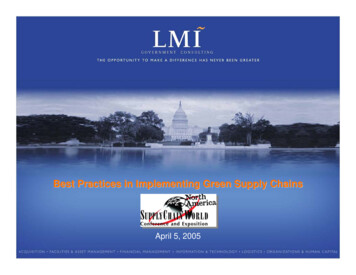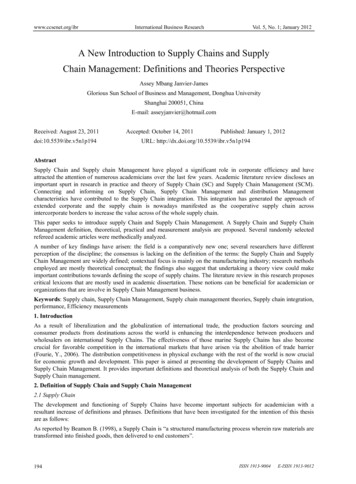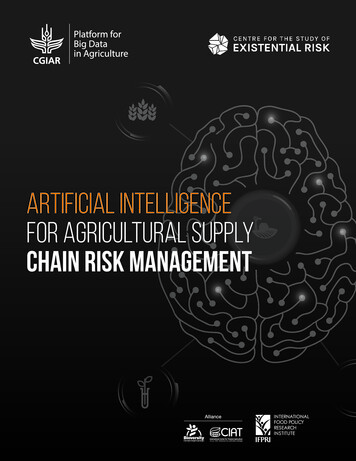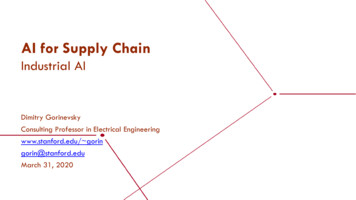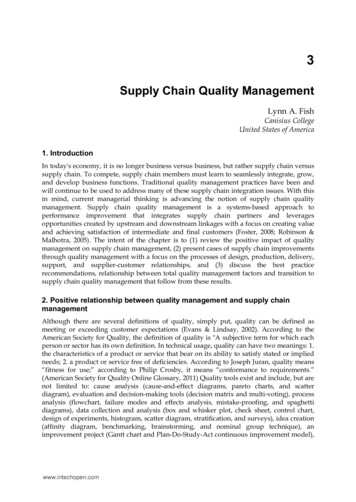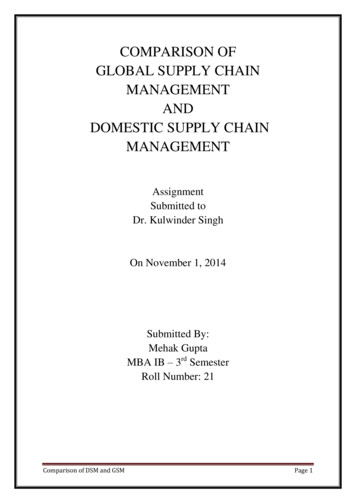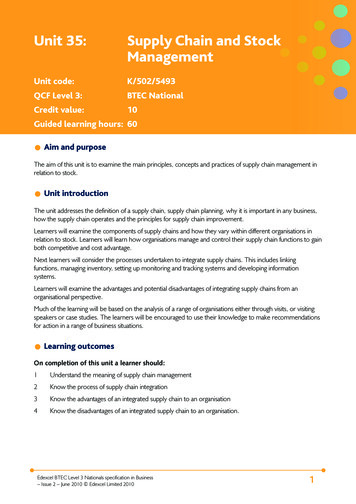
Transcription
Unit 35:Supply Chain and StockManagementUnit code:K/502/5493QCF Level 3:BTEC NationalCredit value:10Guided learning hours: 60Aim and purposeThe aim of this unit is to examine the main principles, concepts and practices of supply chain management inrelation to stock.Unit introductionThe unit addresses the definition of a supply chain, supply chain planning, why it is important in any business,how the supply chain operates and the principles for supply chain improvement.Learners will examine the components of supply chains and how they vary within different organisations inrelation to stock. Learners will learn how organisations manage and control their supply chain functions to gainboth competitive and cost advantage.Next learners will consider the processes undertaken to integrate supply chains. This includes linkingfunctions, managing inventory, setting up monitoring and tracking systems and developing informationsystems.Learners will examine the advantages and potential disadvantages of integrating supply chains from anorganisational perspective.Much of the learning will be based on the analysis of a range of organisations either through visits, or visitingspeakers or case studies. The learners will be encouraged to use their knowledge to make recommendationsfor action in a range of business situations.Learning outcomesOn completion of this unit a learner should:1Understand the meaning of supply chain management2Know the process of supply chain integration3Know the advantages of an integrated supply chain to an organisation4Know the disadvantages of an integrated supply chain to an organisation.Edexcel BTEC Level 3 Nationals specification in Business– Issue 2 – June 2010 Edexcel Limited 20101
Unit content1 Understand the meaning of supply chain managementSupply chain management: definition of a supply chain in relation to stock; main components; variationswithin different organisations; the ‘upstream’ buy-side and the ‘downstream’ sell-side; linear andnetworked configurations; ‘supply chain’ as added value; ‘push and pull’ supply chain models; importancein meeting expectations of marketing functionThe supply chain: producers and processors; suppliers; customers; consumers; distribution organisations;delivery (centralised, decentralised)2 Know the process of supply chain integrationProcess: links with company objectives; linking/integrating production planning; sourcing and procurement;materials handling; inventory management; manufacturing/processing; single process of distribution andafter-sales service; speeding up delivery; mini service staff in call centres dealing with supply exceptions3 Know the advantages of an integrated supply chain to an organisationAdvantages: implications for human resource management; implications for organisational rationalisation;re-visioning staff to strategic goals rather than functional ones; opportunity for dramatically higher volumeand speed of transactions; opportunity to maintain/increase market position; reduced supply chaincomplexity; potential for smooth process operations following complex initial set-up; enhanced, lean andagile systemsOpportunities for greater reliability: implications for use of just-in-time (JIT) production techniques;implications for negotiation of purchase contracts with suppliers; opportunities for improvement inpayment and cash flow; advantages of integration such as lower operating costs and online order trackingas a marketing point eg global courier industry4 Know the disadvantages of an integrated supply chain to an organisationVulnerability: external unforeseen shocks; changes to supply chains from e-business; difficulty of meetingraised customer expectations for delivery reliability; risks of increased dependence on linked supplychain processes; difficulties of partnership negotiations; need for real-time databases for effective logisticsmanagement and online tracking facilities; complexities of implementing in an industry-specific mannereg integrating buyer systems with supplier systems; security problems (billing and payment procedures)2Edexcel BTEC Level 3 Nationals specification in Business– Issue 2 – June 2010 Edexcel Limited 2010
Assessment and grading criteriaIn order to pass this unit, the evidence that the learner presents for assessment needs to demonstrate thatthey can meet all the learning outcomes for the unit. The assessment criteria for a pass grade describe thelevel of achievement required to pass this unit.Assessment and grading criteriaTo achieve a pass grade theevidence must show that thelearner is able to:To achieve a merit grade theevidence must show that, inaddition to the pass criteria,the learner is able to:P1explain the meaning of supplychain managementP2explain how supply chains forthree different products havebeen developedP3describe ways in which asupply chain for a selectedproduct has been integratedM1 explain how the integrationof the supply chain for aselected product could befurther improvedP4describe the potentialadvantages of an integratedsupply chain overconventional non-integratedapproaches for a selectedorganisation[IE]M2 explain how an integratedsupply chain may contributeto the increased effectivenessfor a selected organisationP5describe the potentialM3 explain the circumstancesdisadvantages of dependenceunder which supply chainon an integrated supply chainintegration may fail towith reference to a selectedenhance organisationalorganisation.effectiveness with reference[IE]to a selected organisation.To achieve a distinction gradethe evidence must show that,in addition to the pass andmerit criteria, the learner isable to:D1evaluate the degree oforganisational changenecessary to exploit theadvantages of an integratedsupply chain in two selectedbusinesses[IE]D2evaluate and justify the casefor abandoning integratedsupply chain managementwith reference to a selectedorganisation.[IE]PLTS: This summary references where applicable, in the square brackets, the elements of the personal,learning and thinking skills which are embedded in the assessment of this unit. By achieving the criteria,learners will have demonstrated effective application of the referenced elements of the skills.KeyIE – independent enquirersRL – reflective learnersSM – self-managersCT – creative thinkersTW – team workersEP – effective participatorsEdexcel BTEC Level 3 Nationals specification in Business– Issue 2 – June 2010 Edexcel Limited 20103
Essential guidance for tutorsDeliveryThe areas of procurement, stock keeping and logistics are likely to be new to learners who have noexperience of working in these areas so it is advisable to introduce learners to the simple buying and goodshandling processes through investigating how procurement and inventory are managed in the school orcollege. This would then form a basis upon which an understanding of supply chain management can be built.There is a need to explain clearly the nature of the supply chain with its upstream or buy-side anddownstream or sell-side. Throughout the unit learners should be introduced to examples of how the modelsare applied and examples with which they are familiar would be helpful, eg case studies of Waterstonesand Amazon, together with Tesco and Sainsbury’s (www.tesco.com; www.sainsburystoyou.com). Anunderstanding of the complexities of business operations, the connections between production and relatedprocurement, inventory (stock) and distribution activities should be developed incrementally through analysingcase studies. There will be a need to introduce the learners to theoretical concepts but this should beinterspersed with learning activities such as producing graphical representations of supply chains, estimatingthe costs of inventory holdings and making recommendations for improving supply chains. The tutor couldalso draw on any experiences learners may have of integrated supply chains perhaps through their part-timejobs.The importance of organising supply chain management to deliver the level of logistical service promised bymarketing initiatives cannot be overstated. Learners should visit, or see DVDs, of a sophisticated integratedsupply chain and evaluate the benefits, cost savings and competitive advantages. Learners could also analysewell-known instances of supply chain failure such as Sainsbury’s empty supermarket shelves, the fence panelshortage of 2007 and instances involving the armed forces. At the time of writing business leaders are beingchallenged by unforeseen, large scale changes, brought about by the “credit crunch” so learners can considerthe dilemma faced by businesses in deciding how interdependent and complex a supply chain to set up.Learners should be able to see both sides of the argument: on the one hand the potential advantages ofincreased efficiency and reduced costs, and on the other hand the greater vulnerability to unforeseen changes.Outline learning planThe outline learning plan has been included in this unit as guidance and can be used in conjunction with theprogramme of suggested assignments.The outline learning plan demonstrates one way in planning the delivery and assessment of this unit.Topic and suggested assignments/activities and/assessmentIntroduction to unit and programme of learningWhole group teaching – basic procurement and stock holding processes based on the school/college – visit froma buyerSmall group work – learners identify advantages and disadvantages of methods used on own school/college andshare with rest of groupWhole group teaching – supply chain – upstream, downstreamIndividual exercise – learners draw supply chain based on case studyVisit to a production environment with some level of integration of supply chainIndividual exercise – learners draw chart showing supply chain(s) from the visitWhole group teaching – watch DVD on very integrated supply chain, identifying features4Edexcel BTEC Level 3 Nationals specification in Business– Issue 2 – June 2010 Edexcel Limited 2010
Topic and suggested assignments/activities and/assessmentSmall group work – learners discuss whether practices in DVD example could be applied to productionenvironment from the visit and make recommendationsWhole group teaching based on case studies – supply chain management and marketing – the interface and thechance to add valuePair work based on case study with data – learners work out the amount a company could save throughreducing stockholdingsWhole group – visit to production environment using ERP, or DVD showing how system works leading to pairsof learners identifying processes and benefitsWhole group teaching based on case study of supplier partnerships leading to discussion on advantages and risksWhole group teaching – ECR and other SCM models using case studies and discussionsWhole group teaching – visit to information specialist for input on setting up and maintaining an appropriateinformation systemPair work – based on case study of poor introduction of information system – learners highlight what wentwrong and make recommendations for remedying it.Assignment 1: Supply Chains and Products – based on a visit or case study with extra independentresearchWhole group teaching – implications of introducing integrated SCM for human resource managementSmall group work based on case study of organisation introducing integrated SCM. Learners devise methods ofintroducing change to staffWhole group teaching on marketplace and efficiency advantages of integrated SCMPair work based on case study – learners define and estimate tangible benefits such as lead times, savings fromreduced handling and reduced inventory etc. – PlenarySmall group work based on selection of news items that may have relevance to supply chains – learners identifypossible implications and industries at risk and share results with others (could be a competition)Whole group teaching based on risks not covered by learners and using case studiesAssignment 2: Supply Chain for the Organisation – based on a visit or case study with extraindependent researchSupervised assignment timeNon-supervised study time and completion of assignmentsAssessmentFor the first two learning outcomes the assessment is based on explanations and descriptions of the supplychains for different products. The products can be from the same organisation or from different organisationsbut the supply chains themselves should be different. It would be helpful to learners if there is someidentifiable scope for further integration of the supply chain.For P1, learners need to explain the meaning of supply chain management; as always explanations should bein the learners’ own words and use examples.P2 will be achieved if learners explain how supply chains for three different products have been developed.Learners are not expected to write lengthy descriptions, but should cover the breadth of the supply chain.This could be achieved by an oral presentation. Evidence of this should include an individual observationrecord supplemented by other evidence such as learner’s notes and/or visual aids.For P3, learners can use one of the products from P2. The description should include relevant items from theunit content applied to the selected product.Edexcel BTEC Level 3 Nationals specification in Business– Issue 2 – June 2010 Edexcel Limited 20105
To achieve M1 learners should build on P2 and P3 and explain how the integration of the supply chain fora selected product could be further improved. The learners should explain how at least three methods ormodels such as linking production planning and sourcing, minimising inventory, using ERP or introducing aVPN could be used to improve integration for the selected product. Generic information on the techniqueswill not satisfy the criterion.For the remaining learning outcomes the focus is on the organisation rather than the product. It may bepossible for learners to use the same organisation as they did for the previous learning outcomes or it maybe beneficial to use a different organisation. It may also be advantageous for learners to select differentorganisations for learning outcomes 3 and 4. If the same organisation is used the learners could be presentedwith a different set of external circumstances for learning outcome 4. Whatever is decided it is important thatthe learner has sufficient access to information about the organisation(s) to fully address the criteria.To achieve P4 learners should describe the advantages of an integrated supply chain over conventionalapproaches. The advantages must be specific to the organisation and should include the relevant parts of unitcontent.For M2, the learners develop P4 into a full explanation where they link the advantages to the needs of theorganisation.For D1, this is further developed into an evaluation of the degree of change necessary to exploit theadvantages of an integrated supply chainFor P5, learners should describe the potential disadvantages of dependence on an integrated supply chain andas for P4 it is important that these are specific to the organisation, rather than generic. The learners’ responsesshould include consideration of the items of content listed under ’Vulnerability’.For M3, learners show a greater ability to apply the unit content through explaining the circumstances inwhich an integrated supply chain may not produce the anticipated improvements for the organisation.For D2, this is further developed into an evaluation and justification of the case for abandoning integratedsupply chain management for the selected organisation.Programme of suggested assignmentsThe table below shows a programme of suggested assignments that cover the pass, merit and distinctioncriteria in the grading grid. This is for guidance and it is recommended that centres either write their ownassignments or adapt Edexcel assignments to meet local needs and resources.Criteria coveredAssignment titleScenarioAssessment methodP1, P2, P3, M1Supply Chains andProductsLearners work for anorganisation with varying levelsof supply chain integrationand they are asked to analysesupply chains of products inthe same industry.Learners use case studies toanalyse supply chains for threedifferent products and for oneproduct they explain how it couldbe improved.P4, P5, M2, D1Supply Chain for theOrganisationLearners work for anorganisation consideringintegrating its supply chain.Learners produce a reportdescribing the advantages anddisadvantages of an integratedsupply chain and evaluating theimpact on the organisation.6Edexcel BTEC Level 3 Nationals specification in Business– Issue 2 – June 2010 Edexcel Limited 2010
Links to National Occupational Standards, other BTEC units, other BTECqualifications and other relevant units and qualificationsThis unit forms part of the BTEC Business sector suite. This unit has particular links with the following unittitles in the Business suite:Level 3The Business EnvironmentIntroduction to MarketingThe Impact of Communications Technology on BusinessWebsite Design Strategy.This unit links to the National Occupational Standards for Marketing and Sales Non-specialists Unit 1 and 4.Essential resourcesFor this unit learners should have access to a suitable business teaching environment with access to theinternet to carry out research. Tutors may consider building a bank of resource materials to ensure there is asufficient supply of relevant information across a range of business types and sectors.Learners can generate evidence from a work placement or work experience. Other students may haveaccess to information related to family owned and run businesses.Employer engagement and vocational contextsFor this unit learners should select an organisation and specific products. This will enable them to conductresearch. Visiting speakers from local organisations would provide learners with a wider understanding ofthe range of products that are used and managed in different sectors. Visits to organisations to observeat first hand the way in which supply chains operate would complement the input from visiting speakers.Centres should develop links with local businesses. Many businesses and chambers of commerce want topromote local business so are often willing to provide work placements, visit opportunities, information aboutbusinesses and the local business context and visiting speakers.The website www.businessbritainuk.co.uk provides information about business in Britain and has extensivelinks to other business and business news sites.The Federation of Small Businesses (www.fsb.org.uk) provides information support and guidance about smallbusinesses in the UK.Indicative reading for learnersTextbooksBowersox D, Closs D and Bixby-Cooper M – Supply Chain Logistics Management (McGraw-Hill, 2006)ISBN 0071254145Christopher M – Logistics and Supply Chain Management (FT Prentice Hall, 2004) ISBN 0273681761Emmett S – Supply Chain in 90 minutes (Management Books 2000 Ltd, 2005) ISBN 1-85252-476-6)Gattorna J – Living Supply Chains: How to Mobilize the Enterprise Around Delivering What Your Customers Want(FT Prentice Hall, 2006) ISBN 0273706144Edexcel BTEC Level 3 Nationals specification in Business– Issue 2 – June 2010 Edexcel Limited 20107
JournalLogistics & Transport Focus (The Chartered Institute of Logistics and Transport (UK))Websiteswww.ciltuk.org.ukThe Chartered Institute of Logistics and Transport (UK)www.cips.orgThe Chartered Institute of Purchasing and Supplywww.conspectus.comIndependent monthly IT reports on a range of different topicswww.dell.comDell computers and technology solutionswww.itoi.comWeb resources and informationwww.rswww.comEurope-wide distribution of industrial maintenance and repair productswww.sainsburystoyou.co.ukSainsbury’s online shoppingwww.shellchemicals.comShell Waterstones page on Amazon.com8Edexcel BTEC Level 3 Nationals specification in Business– Issue 2 – June 2010 Edexcel Limited 2010
Delivery of personal, learning and thinking skillsThe table below identifies the opportunities for personal, learning and thinking skills (PLTS) that have beenincluded within the pass assessment criteria of this unit.SkillWhen learners are Independent enquirersdescribing the potential advantages of an integrated supply chain over conventionalnon-integrated approaches for a selected organisationdescribing the potential disadvantages of dependence on an integrated supplychain with reference to a selected organisationevaluating the degree of organisational change necessary to exploit the advantagesof an integrated supply chain in two selected businessesevaluating and justifying the case for abandoning integrated supply chainmanagement with reference to a selected organisation.Although PLTS are identified within this unit as an inherent part of the assessment criteria, there are furtheropportunities to develop a range of PLTS through various approaches to teaching and learning.SkillWhen learners are Independent enquirersplanning and carrying out research into supply chainsCreative thinkerslooking at advantages and disadvantages of supply chainsReflective learnerssetting goals with success criteriainviting feedback on their own work and dealing positively with praise, setbacksand criticismevaluating their experiences and learning to inform future progressTeam workersWorking in small groups to discuss improving supply chainsmanaging activities to reach agreements and achieve resultsSelf-managersseeking out challenges or new responsibilities and showing flexibility whenpriorities changedealing with competing pressures, including personal and work-related demandsresponding positively to change, seeking advice and support when neededEffective participatorstaking part in group activities, working with others.Edexcel BTEC Level 3 Nationals specification in Business– Issue 2 – June 2010 Edexcel Limited 20109
Functional Skills – Level 2SkillWhen learners are ICT – Use ICT systemsSelect, interact with and use ICT systemsindependently for a complex task to meet avariety of needsresearching supply chainsUse ICT to effectively plan work andevaluate the effectiveness of the ICT systemthey have usedtabulating information about supply chainsICT – Find and select informationSelect and use a variety of sources offinding illustrative materials for presentations and tabulationsinformation independently for a complex task about supply chainscreating diagrams, presentations and tabulations about supplychainsAccess, search for, select and use ICTbased information and evaluate its fitness forpurposeexploring, extracting and assessing the relevance of informationfrom websites about organisationsICT – Develop, present andcommunicate informationEnter, develop and format informationindependently to suit its meaning andpurpose including: text and tables images numbers recordsSelect and use ICT to communicate andexchange information safely, responsibly andeffectively including storage of messages andcontact listsbringing together a variety of materials gathered through researchpreparing information to present to other about supply chainscommunicating with other members of a groupMathematicsUnderstand routine and non-routineproblems in a wide range of familiar andunfamiliar contexts and situationsusing numerical data in relation to supply chainsIdentify the situation or problem and themathematical methods needed to tackle itSelect and apply a range of skills to findsolutionsUse appropriate checking procedures andevaluate their effectiveness at each stageInterpret and communicate solutions topractical problems in familiar and unfamiliarroutine contexts and situationsDraw conclusions and provide mathematicaljustifications10Edexcel BTEC Level 3 Nationals specification in Business– Issue 2 – June 2010 Edexcel Limited 2010
SkillWhen learners are EnglishSpeaking and listening – make a range ofcontributions to discussions and makeeffective presentations in a wide range ofcontextscarrying out group work investigating supply chains and theirstructureworking with others in investigating supply chainsmaking presentations about supply chainsReading – compare, select, read andunderstand texts and use them to gatherinformation, ideas, arguments and opinionsreading about supply chains and their structuresWriting – write documents, includingextended writing pieces, communicatinginformation, ideas and opinions, effectivelyand persuasivelywriting materials to provide information about organisationsEdexcel BTEC Level 3 Nationals specification in Business– Issue 2 – June 2010 Edexcel Limited 2010reading about organisations to obtain data to compare businesssupply chainsproducing labelled charts and diagrams showing the structure ofsupply chains and the links between sections within organisations.11
identifiable scope for further integration of the supply chain. For P1, learners need to explain the meaning of supply chain management; as always explanations should be in the learners' own words and use examples. P2 will be achieved if learners explain how supply chains for three different products have been developed.





